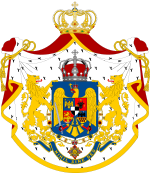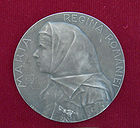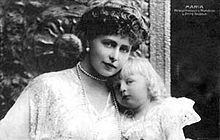- Marie of Romania
-
For her daughter, see Maria of Yugoslavia.
Marie 
Queen consort of Romania Tenure 10 October 1914 – 20 July 1927 Spouse Ferdinand of Romania Issue Carol II of Romania
Elisabeth, Queen of Greece
Maria of Yugoslavia
Prince Nicholas
Princess Ileana, Archduchess of Austria
Prince MirceaFull name Marie Alexandra Victoria House House of Hohenzollern-Sigmaringen
House of Saxe-Coburg-GothaFather Alfred, Duke of Saxe-Coburg and Gotha Mother Grand Duchess Maria Alexandrovna of Russia Born 29 October 1875
Eastwell Park, KentDied 18 July 1938 (aged 62)
SinaiaBurial Curtea de Argeş Cathedral, Romania House of Hohenzollern-Sigmaringen Carol I Queen Consort: Elisabeth Children: Princess Maria Ferdinand I Queen Consort: Marie Children: Prince Carol Elisabeth, Queen of Greece Maria, Queen of Yugoslavia Prince Nicholas Ileana, Archduchess of Austria Prince Mircea Carol II Children: Prince Michael Michael I Queen Consort: Anne Children Princess Margarita Princess Elena Princess Irina Princess Sophie Princess Maria British Royalty House of Saxe-Coburg and Gotha 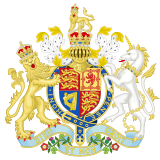
Descendants of Prince Albert Grandchildren Alfred of Edinburgh Marie of Edinburgh Victoria of Edinburgh Alexandra of Edinburgh Beatrice of Edinburgh Margaret of Connaught Arthur of Connaught Patricia of Connaught Alice of Albany Carl Eduard, Duke of Saxe-Coburg & Gotha Marie of Romania (Marie Alexandra Victoria, previously Princess Marie of Edinburgh; 29 October 1875 – 18 July 1938) was Queen consort of Romania from 1914 to 1927, as the wife of Ferdinand I of Romania.
Contents
Early life
She was born on 29 October 1875 at Eastwell Park in Kent, the eldest daughter of Prince Alfred, Duke of Edinburgh, and Grand Duchess Maria Alexandrovna of Russia. Her father was the second-eldest son of Queen Victoria and Prince Albert. Her mother was the only surviving daughter of Alexander II of Russia and Maria Alexandrovna of Hesse. She was baptised in the Private Chapel of Windsor Castle on 15 December 1875 and her godparents were the Empress and Tsarevitch of Russia (her maternal grandmother and uncle), the Duchess of Saxe-Coburg and Gotha (her paternal grandaunt), the Princess of Wales (her paternal aunt) and the Duke of Connaught (her paternal uncle). As her father was in the Royal Navy, she spent much of her early childhood abroad, particularly in Malta.[1]
Marriage
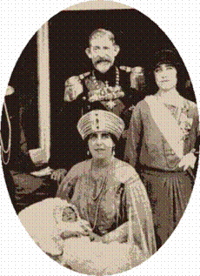 King Ferdinand and Queen Marie of Romania, photographed in Belgrade in 1923 at the christening of her grandson Prince Peter of Yugoslavia. Standing right is The Duchess of York
King Ferdinand and Queen Marie of Romania, photographed in Belgrade in 1923 at the christening of her grandson Prince Peter of Yugoslavia. Standing right is The Duchess of York
In her youth, Princess Marie was considered a suitable match for marriage to the Royalty of Europe. Her first cousin, Prince George of Wales, later King George V of the United Kingdom, fell in love with her and proposed marriage. Marie's father and George's father approved of the marriage, but their mothers did not. Marie's mother did not like the British Royal family and George's mother did not like Germans so the idea of a marriage was nixed. Before Marie could find someone else suitable to marry, her mother found Ferdinand of Romania. He was the German-raised nephew of the King of Romania (and a distant cousin of the rulers of Prussia.)
Princess Marie married Prince Ferdinand of Romania, nephew of King Carol I of Romania in Sigmaringen, Germany, on 10 January 1893. The bride was 17 years old and the groom was 10 years her senior. (Marie's father did not become Duke of Saxe-Coburg-Gotha until a few months later.) The marriage, which produced three daughters and three sons, was not a happy one.[2] Her correspondence with her longtime secret confidante, the American dancer Loie Fuller, revealed "the distaste, which grew to revulsion" that Marie felt for her husband.[3]
The couple's two youngest children, Ileana and Mircea, were born after Marie met her long-time lover, Barbu Ştirbey. Historians generally agree that Ştirbey was the father of Prince Mircea, who had brown eyes like Ştirbey, unlike Marie and Ferdinand.[4] The paternity of Ileana is uncertain, as is the paternity of Marie's second daughter, Maria (known as Mignon), the future Queen of Yugoslavia.[2] Ferdinand's paternity of the three other children, Carol, Nicholas and Elisabeth, has not been disputed.[citation needed]
Affair with Cantacuzene
In 1897, while still Crown Princess, Marie began a romantic liaison with Lieutenant Zizi Cantacuzene.[2] The affair and subsequent scandal became widely known and was quickly terminated by King Carol I. However by autumn 1897, during the height of the scandal, Marie became pregnant. After fleeing to her mother in Coburg, Marie apparently gave birth to a child who has disappeared from history.[2] It has been suggested that the child was either stillborn or quickly placed in an orphanage. Whatever the truth, 'the story of this mysterious child of Marie of Romania was one secret "she took to the grave."'[clarification needed]
Birth of Maria, future Queen of Yugoslavia
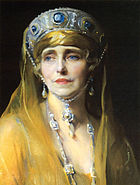 Queen Marie of Romania, portrait by Philip de László.
Queen Marie of Romania, portrait by Philip de László.
In 1899 Marie, pregnant with Mignon, pleaded with King Carol I to allow her to give birth in Coburg, where her father was Duke. Upon the king's refusal of this request, Marie declared 'right to his face' that the child she was carrying was in fact Grand Duke Boris Vladimirovich of Russia's.[2] The horrified King relented and Marie gave birth to her daughter, also called Marie but always known as Mignon, in the peaceful surroundings of Coburg. Following this, whether in earnest or merely to deflect criticism from the dynasty, Crown Prince Ferdinand officially recognised the child as his.
Birth of Prince Nicolas
Marie's fourth child and second son, Prince Nicolas, was born in August 1903. The appearance of Pauline Astor, the sister of Marie's close friend and confidant Waldorf Astor, along with an Astor family doctor during the birth fanned speculation that the father of Prince Nicolas was in fact Astor and not Crown Prince Ferdinand. As with Mignon, Ferdinand accepted the child as his own and as he grew up Nicolas came to resemble his Hohenzollern relatives rather than the Astors.[2]
Queen and Queen Mother
In 1914, Carol I died and Ferdinand ascended the throne of Romania. Crown Princess Marie then became styled Her Majesty The Queen of Romania. Due to World War I, they were not crowned as King and Queen until 1922.
Marie had become a Romanian patriot, and her influence in the country was large. A.L. Easterman writes that King Ferdinand was "a quiet, easy-going man, of no significant character… It was not he, but Marie who ruled in Romania." He credits Marie's sympathies for the Allies as being "the major influence in bringing her country to their side" in the war.[5]
During the war, she volunteered as a Red Cross nurse to help the sick and wounded and wrote a book, My Country to raise funds for the Red Cross, but these were by no means her most notable contributions to the war effort. With the country half-overrun by the German Army, she and a group of military advisers devised the plan by which the Romanian Army, rather than retreating into Russia, would choose a triangle of the country in which to stand and fight; and through a letter to Loïe Fuller she set in motion the series of events that brought a timely American loan to Romania, providing the necessary funds to carry out the plan. (Fortuitously, the young woman from the US embassy who delivered the letter to Fuller was the former ward of Newton D. Baker, by this time serving as U.S. Secretary of War. Fuller and the young woman travelled from Paris to Washington, DC and secured an audience with Baker who, along with U.S. Secretary of the Treasury Carter Glass, arranged the loan.)
After the war ended, the Great Powers decided to settle affairs at the Paris Peace Conference. The Romanian objective was to secure the Romanian-inhabited territories from the now-defunct Austria-Hungary and Russian Empire, thereby uniting all Romanian-speakers in a single state. Romanian diplomats at the peace conference sought to achieve recognition by the Allies of the Unions of Bessarabia, Bukovina, and Transylvania with Romania, proclaimed during 1918. With the Romanian delegation losing ground in the negotiations, Prime Minister Ionel Bratianu called upon the Queen to travel to France. Marie famously declared that "Romania needs a face, and I will be that face," astutely calculating that the international press was growing tired of the endless negotiations and would be unable to resist the glamour of a Royal visit. The arrival of the so-called Soldier Queen was an international media sensation and she argued passionately that the Western powers should honour their debt to Romania (which had suffered a casualty rate proportionately far greater than Britain, France or the USA). Behind the scenes, she alternately charmed and bullied the Allied leaders into backing the Romanian cause.[2] As a direct result of her charismatic intervention, Romania won back the initiative and successfully achieved all its pre-conference aims, eventually expanding its territory by 60%, gaining Bessarabia, Bukovina, Transylvania, as well as parts of the Banat, Crişana and Maramureş.
Marie's son, the Crown Prince Carol (later King Carol II of Romania), was never close to his father, Ferdinand—by the time Carol was an adult, their antagonism became an "open breach"[5]—but there continued to be a "deep bond of affection and sympathy" between Carol and Marie.[5] Their relationship, however, deteriorated. The initial conflict came over Carol's objections to Marie's relationship with Prince Ştirbey; the breach was exacerbated as Marie attempted to steer Carol toward a dynastic marriage rather than allow him to choose his own bride.[5] During Carol's exile in Paris, Loïe Fuller had befriended Carol and his mistress Magda Lupescu; they were unaware of Fuller's connection to Marie. Fuller initially advocated to Marie on their behalf, but later schemed unsuccessfully with Marie to separate Carol from Lupescu.[3] Eventually, when Carol became King and did not seek her counsel, the breach between mother and son became complete.[6]
After the death of her husband in 1927, Queen Marie remained in Romania, writing books and her memoirs, The Story of My Life. She died in Peleş Castle on 18 July 1938, and was buried next to her husband in the Monastery of Curtea de Argeş. In accordance with her will, her heart was kept in a cloister at the Balchik Palace which she had built. In 1940, when Balchik and the rest of Southern Dobrudja were returned to Bulgaria in accordance with the Treaty of Craiova, Queen Marie's heart was transferred to Bran Castle. This had been her principal home for much of the early 20th century, and the artefacts with which she chose to surround herself (traditional furniture and tapestries, for example) can be seen by visitors today. Many of her other personal effects can be seen at the Maryhill Museum, formerly the home of Samuel Hill, an American railroad businessman with whom Queen Marie corresponded much of her life. The famous museum, which lies in Washington State (U.S.A.) on the north side of the Columbia River, displays much of Queen Marie's regalia, furniture, and other possessions, including her crown.
She was the 1,007th Dame of the Royal Order of Queen Maria Luisa.
Religious beliefs
She is held in high esteem by members of the Bahá'í Faith. Her religious background was of the Church of England, although she is known to have embraced the Orthodox Christian beliefs of Romanian nationals. In her later years, she was approached by Martha Root, a well-recognized travelling teacher, on the topic of the Bahá'í Faith. Bahá'ís recognise Queen Marie of Romania as the first member of royalty to have declared her belief in Bahá'u'lláh, the founder of the Bahá'í Faith.[4][7][8]
In regard to the Bahá'í Faith, Queen Marie stated:
"The Bahá'í teaching brings peace and understanding. It is like a wide embrace gathering together all those who have long searched for words of hope. It accepts all great Prophets gone before, it destroys no other creeds and leaves all doors open. Saddened by the continual strife amongst believers of many confessions and wearied of their intolerance towards each other, I discovered in the Bahá'í teaching the real spirit of Christ so often denied and misunderstood: Unity instead of strife, Hope instead of condemnation, Love instead of hate, and a great reassurance for all men."[9]
Titles, styles, honours and arms
 Marie's coat of arms
Marie's coat of arms
Titles and styles
- 29 October 1875 – 10 January 1893: Her Royal Highness Princess Marie of Edinburgh, Princess of the United Kingdom of Great Britain and Ireland, Princess of Saxe-Coburg-Gotha, Duchess of Saxony
- 10 January 1893 – 10 October 1914: Her Royal Highness Crown Princess of Romania
- 10 October 1914 – 20 July 1927: Her Majesty The Queen of Romania
- 20 July 1927 – 18 July 1937: Her Majesty Queen Marie of Romania
British arms
As a male-line grandchild of a British Sovereign, Marie bore the arms of the kingdom, with an inescutcheon for Saxony, differenced by a five-point label argent, the outer pair of which bore anchors azure, the inner roses gules, and the central a cross gules. In 1917, the inescutcheon was dropped by Royal Warrant from George V.[10]
Issue
Name Birth Death Notes Carol II of Romania 15 October 1893 4 April 1953 (aged 59) married Elena of Greece and Denmark, sister of King George II of Greece Elisabeth 12 October 1894 14 November 1956 (aged 62) married King George II of Greece Maria 6 January 1900 22 June 1961 (aged 61) married King Alexander I of Yugoslavia Nicholas 3 August 1903 9 June 1978 (aged 74) married Ioana Dumitrescu-Doletti then Thereza Lisboa Figueiroa de Mello Ileana 5 January 1909 21 January 1991 (aged 82) married Archduke Anton of Austria, Prince of Tuscany Mircea 3 January 1913 2 November 1916 (aged 3) Quote
She once encountered a proselytiser from a religious group. She said "I have met.....I did not like him. He seemed to me to be a snob. He spoke of God as if He were the oldest title in the Almanach de Gotha. And all that business about telling one's sins in public – He wanted me...me ...to get up before my children and confess everything I had ever done! It is spiritual nudism! Ça ne se fait pas."[11]
Legacy
Literature
She was also referred to in a number of contemporaneous literary sources, including Dorothy Parker's poem "Comment":
-
- Oh, life is a glorious cycle of song,
- A medley of extemporanea;
- And love is a thing that can never go wrong,
- And I am Marie of Roumania.
Marie's interaction with the Bahá'í faith's is discussed in Her Eternal Crown: Queen Marie of Romania and the Bahá'í Faith, by author Della L. Marcus.
Science fiction author Joanna Russ mentions her in her 1975 novel, The Female Man.
Bruce Benderson, in The Romanian: Story of an Obsession, soliloquizes on the relationship between Marie, her son King Carol II and his mistress Magda Lupescu.
Sylvia the dog, in the play Sylvia by A. R. Gurney, says near the end of Act 2, "Oh sure. And I'm Marie of Rumania."
Other
In 2005, a Type 22 frigate Regina Maria (formerly HMS London in the Royal Navy) was named after Marie by the Romanian Navy.
Ancestry
References
See also
- List of British princesses
- Samuel Hill
- Maryhill Museum of Art
Sources
- Fotescu, Diana (1998). Americans and Queen Marie of Romania. Portland, Oxford: Iasi.
- Mandache (Fotescu), Diana (2004). Later Chapters of My Life. The Lost Memoir of Queen Marie of Romania. Sutton. ISBN 978-0750936910.
- Mandache (Fotescu), Diana (2007). Marie of Romania. Images of a Queen. Rosvall Royal Books. ISBN 9197567124. http://www.tkinter.org/QueenMarie/RecentBooks/MarieImagesOfQueen/index.htm.
Footnotes
- ^ Yvonne's Royalty Home Page – Royal Christenings
- ^ a b c d e f g Julia Gelardi (2005). Born to Rule, Granddaughters of Queen Victoria, Queens of Europe. Headline Book Publishing. pp. 91–93&115. ISBN 0755313925.
- ^ a b Easterman, 1942, 58–61
- ^ a b Pakula (1985). The last romantic: a biography of Queen Marie of Romania. London: Weidenfeld & Nicolson. pp. 337. ISBN 0297785982.
- ^ a b c d Easterman, 1942, 28–32
- ^ Easterman, 1942, 31, 86–87
- ^ Marcus, Della (2000). Her Eternal Crown. Oxford: George Ronald. ISBN 0853984425.
- ^ Hassall, Graham; Fazel, Seena. "100 Years of the Baha'i Faith in Europe". Baha'i Studies Review 8 (3): 35–44. http://bahai-library.com/hassall_fazel_100-years_europe&language=All#N_26_. Retrieved 26 April 2007.
- ^ Effendi, Shoghi (1991). The World Order of Baha'u'llah. Selected Letters. Wilmette, Illinois, USA: Bahá'í Publishing Trust. pp. 234. ISBN 0877432317. http://reference.bahai.org/en/t/se/WOB/wob-36.html.
- ^ Heraldica – British Royalty Cadency
- ^ Nichols, Beverely (1952). All I could Never Be. Dutton. pp. 255–256.
External links
- Queen Marie of Romania
- Ars Reginae. Romania's Writer-Queens
- Find A Grave
- The British Pathé has made available various archives of films taken including Marie of Edinburgh:1914, 1917, 1924, 1930, 1930, 1931, 1932, 1938
Marie of RomaniaCadet branch of the House of WettinBorn: 29 October 1875 Died: 18 July 1938Romanian royalty Preceded by
Elisabeth of WiedQueen consort of Romania
10 October 1914 – 20 July 1927Vacant Awards and achievements Preceded by
William SprouleCover of Time Magazine
4 August 1924Succeeded by
John J. PershingBritish princesses The generations indicate descent from George I, who formalised the use of the titles prince and princess for members of the British Royal Family. Where a princess may have been or is descended from George I more than once, her most senior descent, by which she bore or bears her title, is used. 1st generation 2nd generation 3rd generation - Augusta, Duchess of Brunswick
- Princess Elizabeth
- Princess Louisa
- Caroline Matilda, Queen of Denmark and Norway
4th generation 5th generation 6th generation 7th generation - Louise, Princess Royal and Duchess of Fife
- Princess Victoria
- Maud, Queen of Norway
- Marie, Queen of Romania
- Victoria Melita, Grand Duchess of Hesse
- Alexandra, Princess of Hohenlohe-Langenburg
- Beatrice, Duchess of Galliera
- Margaret, Crown Princess of Sweden
- Patricia of Connaught
- Alice, Countess of Athlone
- Marie Louise, Princess Maximilian of Baden
- Alexandra, Grand Duchess of Mecklenburg-Schwerin
- Olga of Hanover
8th generation 9th generation - Queen Elizabeth II
- Margaret, Countess of Snowdon
- Alexandra, The Hon Lady Ogilvy
10th generation 11th generation Princesses (by birth) of Saxe-Coburg and Gotha, duchesses in Saxony 1st generation none2nd generation Victoria, Duchess of Nemours · Charlotte, Empress of Mexico*3rd generation Victoria, German Empress** · Alice, Grand Duchess of Hesse and by Rhine** · Helena, Princess Christian of Scheswig-Holstein** · Louise, Duchess of Argyll** · Beatrice, Princess Henry of Battenberg** · Clotilde, Archduchess Joseph Karl of Austria · Amalie, Duchess Maximilian Emanuel in Bavaria · Louise-Marie, Princess of Kohary* · Stéphanie, Crown Princess of Austria* · Henriette, Duchess of Vendôme* · Princess Joséphine-Marie* · Clémentine, Princess Napoléon* · Joséphine-Caroline, Princess Karl Anton of Hohenzollern*4th generation Louise, Duchess of Fife** · Princess Victoria** · Maud, Queen of Norway** · Marie, Queen of Romania** · Victoria Melita, Grand Duchess Cyril Vladimirovich of Russia** · Alexandra, Princess of Hohenlohe-Langenburg** · Beatrice, Duchess of Galliera** · Margaret, Crown Princess of Sweden** · Lady Patricia Ramsay** · Alice, Countess of Athlone** · Dorothea, Duchess of Schleswig-Holstein-Sonderburg-Augustenburg · Marie-José, Queen of Italy*5th generation Mary, Countess of Harewood** · Sibylla, Duchess of Västerbotten** · Caroline Mathilde, Countess of Castell-Rüdenhausen** · Princess Clementine, Mrs. Edward von Heller · Princess Maria Caroline · Theresia, Freifrau von Taxis di Bordogna e Valnigra · Princess Leopoldine · Princess Maria Immaculata · Josephine, Freifrau von Baratta-Dragono6th generation Princess Claudia, Mrs. Gion Schäfer · Beatrice Charlotte, Princess of Saxe-Meiningen7th generation Princess Stephanie · Princess Felicitas Franziska, Mrs. Sergei Trotzki* also a princess of Belgium
** also a princess of the United Kingdom of Great Britain and IrelandCategories:- Romanian royal consorts
- Queens consort
- British princesses
- Romanian princesses
- Princesses of Hohenzollern-Sigmaringen
- House of Saxe-Coburg and Gotha
- House of Hohenzollern-Sigmaringen
- British nurses
- Romanian memoirists
- Romanian women writers
- Romanian philanthropists
- English Bahá'ís
- Romanian Bahá'ís
- Converts to the Bahá'í Faith from Eastern Orthodoxy
- Companions of the Order of the Crown of India
- Dames of Justice of the Order of St John
- Ladies of the Royal Order of Victoria and Albert
- Members of the Royal Red Cross
- People from Ashford, Kent
- 1875 births
- 1938 deaths
- Burials at Curtea de Argeş Cathedral
- Dames of the Order of Queen Maria Luisa
- Recipients of the Order of the White Eagle (Poland)
- 20th-century Bahá'ís
- Bahá'í monarchs
Wikimedia Foundation. 2010.

